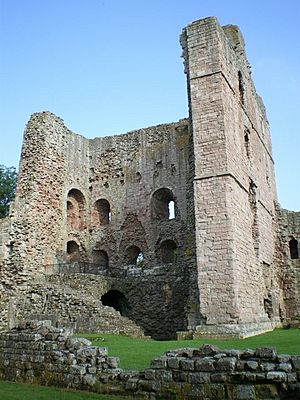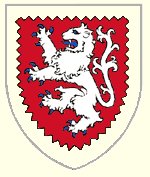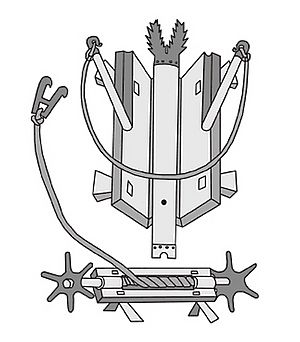Thomas Grey (constable) facts for kids
Quick facts for kids
Sir
Thomas Grey of Heaton
|
|
|---|---|
| Died | before Mar 1344 |
| Allegiance | England |
| Service/ |
Army |
| Rank | Knight Banneret |
| Commands held | Warden of Cupar Castle Keeper of Norham Castle Deputy Constable of Berwick-upon-Tweed Keeper of Mitford Castle |
| Battles/wars | Action at Lanark (1297) Siege of Stirling Castle (1304) Ambush at Cupar Castle (1308) Battle of Bannockburn (1314) Capture of Berwick (1318) Siege of Norham (1322) Invasion of England (1326) |
| Spouse(s) | Agnes de Bayles |
| Relations | Thomas Grey (chronicler) |
Sir Thomas Grey (died before March 1344) was a brave soldier from Heaton Castle in Northumberland. He fought in the Wars of Scottish Independence, which were battles between England and Scotland. His son, also named Thomas Grey, wrote down his father's adventures. These writings give us a special look into what daily life was like during these wars. Even though he was captured at the Battle of Bannockburn, Sir Thomas is perhaps best known for a brave rescue he made at Norham Castle.
Contents
Sir Thomas Grey's Military Career
Early Adventures
Sir Thomas Grey started his military service as early as 1297. He was working for William de Hesilrig, who was the Sheriff of Clydesdale. One night, William Wallace attacked the Sheriff in Lanark. Grey was badly hurt and left for dead in the snow. Luckily, the heat from burning houses nearby kept him warm enough to survive. He was rescued the next day and recovered from his injuries.
By September 1301, Grey had become a knight. He served with the king's representative in Scotland, Patrick IV, Earl of March, at Ayr.
In May 1303, Grey was with Hugh Audley at Melrose Abbey. They were attacked at night by a much larger Scottish force led by John Comyn. Grey was knocked down and captured, but many of his fellow soldiers were killed.
The Siege of Stirling Castle (1304)
By April 1304, King Edward I had taken control of most of Scotland. He then began a long siege of Stirling Castle, which was the last important Scottish fortress. The siege lasted 19 weeks, and the English used 12 giant siege engines, including a huge trebuchet called "Warwolf".
Grey fought bravely at this siege under the command of Henry de Beaumont. One day, a hook from a siege machine caught de Beaumont and was pulling him towards the castle walls. Sir Thomas Grey quickly freed him and pulled him to safety, saving his life.
Right after this brave act, Grey was hit in the head by a large bolt from a springald (a huge crossbow). He fell to the ground, looking lifeless, and people thought he was dead. They even started preparing for his burial. But just as the funeral ceremony began, Grey suddenly moved and opened his eyes! Everyone was amazed, and he made a full recovery.
Because of this event, Grey might have chosen a ram's head as the crest for his coat of arms. It was a funny way to remember how tough his skull was.
After this, Grey became close to the Beaumont family, who were related to the king and queen. He started to be involved in court life. In 1307, Grey was given the job of looking after Robert Bruce's sister, Christina.
Ambush at Cupar Castle (1308)
When King Edward I died, his son Edward II became king. Grey attended Edward II's coronation in London in February 1308. As Grey was returning to Cupar Castle, where he was in charge, he was ambushed by Walter de Bickerton, a supporter of Robert Bruce.
Grey was greatly outnumbered. He only had 26 soldiers, while Bickerton had 400 men. Instead of trying to escape, Grey decided to charge directly into the middle of Bickerton's men. He used his lance and the force of his horse to knock down many enemies. Seeing his success, his own soldiers joined him. Together, they managed to defeat many of the enemy and scare their horses away.
Before the charge, Grey had told his grooms (people who look after horses) to follow at a distance with a battle flag. When Bickerton's confused men saw the grooms and the flag, they thought it was another group of soldiers arriving. They panicked and ran away. Grey and his men then took 180 of Bickerton's abandoned horses back to his castle as a prize.
Battle of Bannockburn (1314)
Grey's capture at the Battle of Bannockburn was a difficult moment in his career. On the first day of the battle, Grey was serving under Beaumont and Robert Clifford. They tried to go around the Scottish army but were defeated by the forces of Sir Thomas Randolph, Earl of Moray.
On the second day, the English army suffered a huge defeat. The king fled the battlefield with about 500 knights. Hundreds of English soldiers were killed, and many English nobles and knights were taken prisoner, including Sir Thomas Grey.
Defending Norham Castle

After their victory at Bannockburn, the Scottish army often attacked and raided northern England. In 1318, Grey was stationed at Berwick-upon-Tweed. This town fell to Robert Bruce after an 11-week siege. Later, Grey was paid money for his lost horses and for the wages he and his 14 soldiers were owed.
In 1319, Grey was made Sheriff of Norham and Islandshire and the Constable (commander) of Norham Castle. He stayed there for 11 years. During this time, Norham was almost always under siege. It was here that Grey performed his most famous act: rescuing William Marmion.
A two-year peace agreement ended in 1322. Grey promised the king he would recruit more soldiers to protect Norham Castle and the border area. By September 17, Norham was under siege by 100 Scottish soldiers and 100 light cavalry. The king sent Grey money to pay his soldiers and asked for regular updates. He also promised to pay back anyone around the castle who lost crops or goods because of the fighting.
In May 1323, King Edward II agreed to a 13-year peace with Bruce. Three months later, Grey was allowed to go to Scotland to get supplies for Norham Castle, like grain and ammunition. He also needed to replace the plows and carts that had been destroyed. He captured 80 Scots at Norham who had landed at Lindisfarne and were trying to reach Scotland. He was ordered to send them to York Castle.
On July 9, 1325, Grey was told to welcome back any people from Northumberland who had joined the Scottish side because they were poor or had other urgent needs.
Later Years and Family
In 1326, there was a planned invasion of England. Grey was ordered to join the fleet of ships defending King Edward II from his wife, Queen Isabella, and her lover, Roger Mortimer, 1st Earl of March. Grey had to make ships from Northumberland ports join the fleet. However, no naval battle happened. Isabella and Mortimer took control of England easily, and Edward II was imprisoned. Edward III became the new king.
Edward III continued fighting the Scottish. After the Scottish were defeated at the Battle of Halidon Hill in July 1333, Grey was made deputy constable of Berwick. Around 1334, Grey was given Mitford Castle.
Family and Descendants
Sir Thomas Grey married Agnes de Bayles. They had two children:
- Sir Thomas Grey, who was also a soldier and wrote down his father's stories.
- Margaret Grey (died May 27, 1378), who married John Eure de Aton.
Sir Thomas Grey is an ancestor of several important families, including the Earl Greys of Tankerville and the Baron Greys of Powis and Werke.



